Genre: FMV Developer: Psygnosis Publisher: Psygnosis Released: 1994
If there’s one thing the Sega CD had a deserved bad rep for, it’s how full-motion video games looked on it. While 64 on-screen colors could be worked with to create some very nice graphics using sprites and such, it wasn’t the best number to work with when it came to porting video to the add-on. Yet that didn’t deter some companies from trying anyway. They made CGI intros and cinemas, took footage from movies for tie-in games, and had original “interactive” games/movies made using it. Released in 1994 for other systems like DOS computers, the 3DO, the FM-Towns Marty (and a year later, the PlayStation), Psygnosis’ Novastorm was ported over to Sega’s CD add-on that same year in hopes of giving the 16-bit peripheral owners the same experience found on other, more FMV capable, hardware. But is this port a gold star on the Sega CD’s report card, or more like a blemish on its record? Read on.
Three weeks ago, SCARAB, the Star Corps Armored Response Assault Battalions, turned on the very beings that created it. A machine built to fight wars and take humans out of the battlefield equation, SCARAB was also made to help humans find new worlds to live on. But after years of gathering data, and the killing of some 31 intelligent non-human lifeforms as it did its “scorched earth” settlement/terraform strategy, it seems SCARAB now simply wants to take humans out… for good. Something that SCARAB discovered within all the data it had assimilated brought the machine to this idea, and in the three weeks since, millions of lives have been lost to SCARAB’s attacks. What was once a weapon to aid mankind, is now its biggest threat. And as such, SCARAB must be stopped, before humans become the thirty-second life form that it’s wiped out.
This game’s big visual push at its release was the amount of FMV it has in it, a trait that game companies at the time were proud to tout when it was noteworthy. Well, it certainly does have quite a bit. Filling roughly half the screen, each world you visit is made up entirely of video, with little in the way of repeating clips. Though it should be noted that the clips featuring the pilot in the ship do get reused quite a bit, the stages themselves are spared this for the most part. The game’s visuals are split between the FMV backdrop, and sprites for your HUD and ship, the smaller enemies, and a mid-boss or two. The sprites were done using CGI, and are laid over the FMV backdrop, not unlike some older laser disc arcade games such as M.A.C.H. 3. However, the sprites aren’t very colorful, with a lot of grays and muddy hues that don’t make them look as good as they could. You can still tell what each object is, with designs for the ships (sprite and FMV) that range from rather nice (your ship, some of the Darius-like bosses, etc.) to very plain and uninteresting (the RADAR dish boss, some of the small enemies, etc.). That said, they do animate quite smoothly, with plenty of scaling going on that’s also well done. It’s hard to tell if it’s a well-choreographed mix of hardware scaling and sprite positioning for the ship patterns, if all the sprites were pre-rendered for their entire flight paths, or if it’s a mixture of the two. Regardless, the scaling is nicely handled, even if the image quality of the sprites themselves aren’t.
The backgrounds, to be honest, aren’t done much justice here. Some areas look better than others, but the FMV visuals aren’t this game’s strong point in the end. The video footage itself looks interesting, with lots of drifting, loops, and action going on, keeping the visuals from just being like a camera strapped on a rail car (always simply moving forward with no dynamic camera angles). There are plenty of obstacles that you’ll need to dodge, and the four worlds you’ll be watching were designed in such a way as to make them more visually appealing. They’re also pretty diverse, going from fire, to desert, to ice, and finally, technology. But the video is just so watered-down color-wise, that it’s kind of hard to appreciate it, or even make out what’s happening at times. As a result, between the colors of the sprites and the FMV backgrounds, this game’s visuals have the distinct feel of being a quick and dirty port.
On the other hand, the audio for the game is pretty good. The sound effects used are solid, sounding like sampled effects for things like the big bombs, some of the weapon fire and impacts. The problem is, they’re also pretty static-laden at times (especially some of the explosions). But as a whole, they’re of better quality than the average Genesis game. When it comes to the music, things take a step up again. Either loaded into the Sega CD’s memory, or streamed with the video, each world has three or four versions of a single theme song for it, all of which are basically ’90s electronica/house in style. By “versions,” I mean one base composition, remixed three or four times so that it’s not the exact same song throughout each world. The problem is, some takes of each tune are better than others, and the core song is still clearly the same. That said, little of it’s actually bad, but it ranges from generic, to good, so there’s some wavering in the compositional quality as you progress through the game. In total though, the audio fairs much better than the video.
The gameplay is very similar to a lot of other 3D shmups, in that you’re flying into a world, and the goal is the reach the bosses and kill them. But this game gives you more to play with, as along the way, you have quite a few power-ups that can be collected, from triple-shot guns and bombs, to life bar replenishers and shields. These are released when you shoot certain ships in an enemy formation and appear along the top of the play area as three different items to choose from (which is also a nice touch). The four worlds in the game each consist of several sub-sections, and each sub-section comes with its own boss at the end much of the time, giving you plenty of battles of varying difficulty.
Though this game has video for its stages, there’s a little trick it uses to create a level of interactivity with the video. Using z-buffering, the game creates hotspots over top of various parts of the video. Overpasses, the walls of canals, sections and weak points of bosses, and things of that nature, are given these boxes as they zoom past and move about. This is also done in such a way, as to show how far away you are from an object, giving the illusion of depth as well. And of course, if you hit one of these hot spots with your ship or weapons, it’ll cause your ship to bounce off and be damaged, or the object with be struck by your shots, respectively. It gives you the feeling that you’re actually interacting with the worlds, and not just moving a target around over top of it, helping to alleviate some of the “in front of a green screen” feel that FMV games are known for.
So, did anything go wrong with Novastorm? Well, yeah. First and foremost, this is not a pretty game. The visuals were not adjusted with the Sega CD’s 64 on-screen colors in mind, making for a rather iffy looking set of dully colored sprites, and downright ugly video at times. There’s a lot of color flickering going on (areas flashing between two different hues), with strange and unnatural colors being applied to areas. Then there’s the graininess and low clarity that results from these color issues, making it hard to tell what’s coming at you within the stages at times. Hell, the screen will periodically be dominated by one solid color as well. Yes, the video fills about half the screen and runs at a pretty good frame rate, but that does little to alleviate the core problem of the game not being visually optimized better. Another considerable issue, is that the z-buffering on the video also blocks your shots from being able to hit the enemy ships in some areas. This happens mostly in the later stages when you’re weaving between buildings, or racing down tunnels, and it’s very annoying. The enemies are flying where you should clearly be able to hit them, yet the z-buffering is shielding the ships… giving them free shots at you, sometimes for quite a while.
On the more minor side, there are moments when this game is affected by slowdown and flicker. While the latter is reasonably rare, the former comes up often as the game progresses and greater numbers of sprites come zooming in from the distance, and/or flying in from the sides, causing the game to chug. The next minor gripe is that at times, you can tell that something was cut out of this version. An extra scene, a section to play through… there are just areas when the transitions feel abrupt, leaving you with the impression that parts were removed. And finally, there are times when the z-buffering is a bit suspect. You’ll get hit by walls and pipes that you were clearly safe from or get bounced around between objects like a piloted pinball as you try to squeeze through tight space. This happens namely in the later, more crowded stages, and can be pretty frustrating when it costs you either a life, or a lot of your shield.
So how does Novastorm come out at the end? Well, compared to just about every other port of this game, it’s pretty much at the bottom. The game is certainly playable, as the controls are responsive with some momentum drift affecting your ship, the audio’s nice, the z-buffering is handled all right for the majority of the game, it offers up a decent challenge, and there’s plenty of game to play through. But the bad video, failure to clean up most of the sprites, and the questionable z-buffering on the busier sections pull the game down. This kind of game really relies on its video to draw you in, but the end product here shows how little effort was really put into bringing this game over to the FMV-challenged Genesis add-on. There’s not much else to be said except, frankly, play a different version. PlayStation, 3DO, FM-Towns Marty, DOS… they’re all better than the Sega CD port in terms of visuals and how the later stages are handled with the z-buffering. So much so, that I’d give them a good two points on top of this version’s score.
SCORE: 5 out of 10

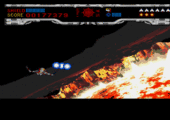
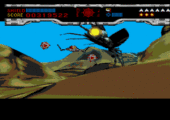
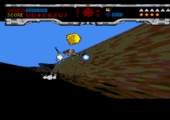
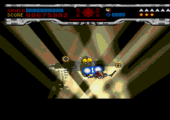
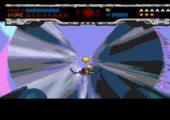
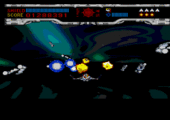
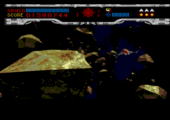
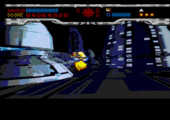
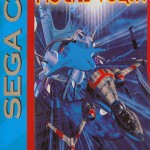
Recent Comments